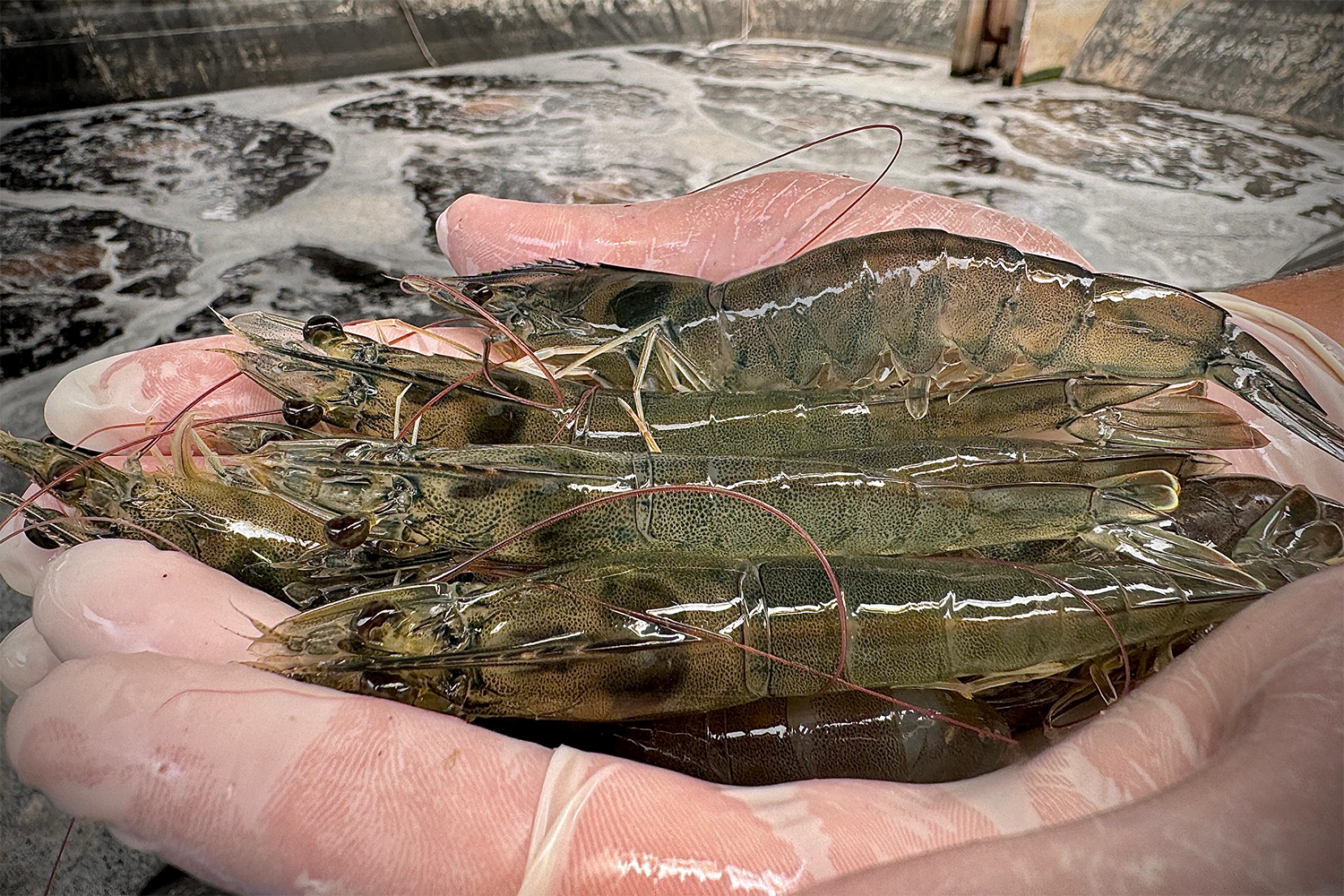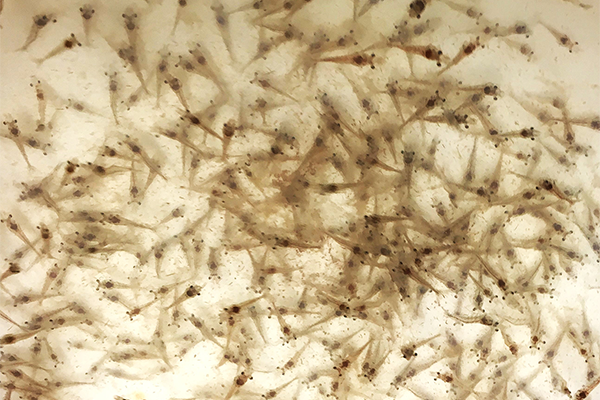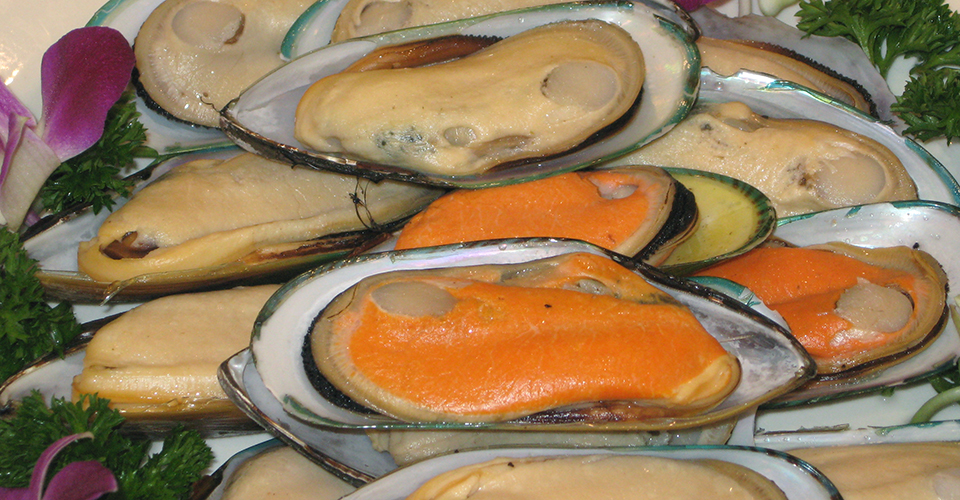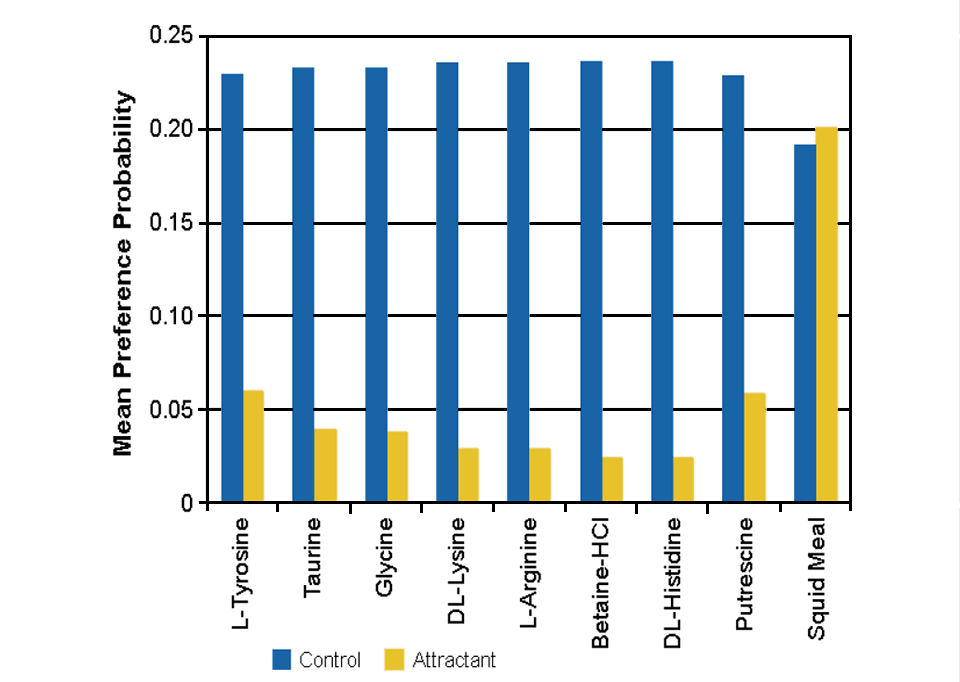Results showed that supplementing diets significantly reduced latency period to spawning

The nutritional requirements of penaeid shrimp broodstock include dietary protein levels in formulated feeds ranging between 45 and 55 percent, typically supplemented with various fresh feeds. Ten amino acids are considered essential (EAA) – including arginine, histidine, isoleucine, leucine, lysine, methionine, phenylalanine, threonine, tryptophan and valine. Amino acids increase the ovarian maturity development and enhance the reproductive performance by yolk proteins, polypeptide hormones, and enzymes biosynthesis. However, information regarding other EAAs, semi-essential or conditionally EAAs such as taurine on reproductive performance of crustaceans is limited.
Taurine is a conditionally essential amino acid for farmed aquatic species based on their life stage, culture condition, health status, dietary biochemical composition, and feed ingredients. Previous studies in various crustaceans, including penaeid shrimp species, have confirmed that taurine can improve growth, feed efficiency, antioxidant capacity, immune responses, disease resistance, and stress tolerance during larvae and juvenile stages. Recent research on some fish species showed that supplementing their diets with taurine markedly improved reproductive performance such as fecundity, fertilization and hatching rates, larval quality and survival rate.
This article – summarized from the original publication (Mozanzadeh, M.T. et al. 2024. Effects of Dietary Taurine on Maturation Indices, Antioxidant Capacity, Ovaries Amino and Fatty Acids Profile, and Vitellogenin Gene Transcription Level in Penaeus vannamei Female Broodstock. Aquaculture Nutrition Volume 2024, Article ID 5532545) – presents the results of research to examine the influence of dietary taurine on some reproductive factors and physiological responses of P. vannamei female broodstock.
Study setup
Subadult shrimp were transported to the Persian Gulf University’s Aquatic Research Laboratory from a greenhouse pond (Bushehr, Iran) and acclimated for two weeks. A total of 180 shrimp broodstock (29.4 ± 0.2 grams) were distributed into 18,250-liter black circular polyethylene tanks. Each tank held five females and five males (1:1 ratio).
Two hundred liters of UV-disinfected seawater was supplied for each tank and equipped with a 300-watt aquarium heater to stabilize the temperature at 28.9 ± 1.4 degrees-C. Water was exchanged at 80 percent daily, and the artificial light photoperiod used was 12 hours light-12 hours dark. Typical fresh feeds such as squid and blood worms, with high levels of taurine, were not used. The experimental diets were fed twice a day at 5 percent of their biomass for the 30-day duration of the trial.
For the experimental diets, a graded amount of Tau ranging from 0 (control), 2, 4, 6, 8 and 10 grams per kg was added to six isonitrogenous (497 grams per kg protein) and isolipidic (140 grams per kg lipid) diets. Dietary energy was formulated to be around 19.0 MJ per kg.
For detailed information on the experimental design, rearing system and animal husbandry; experimental diet preparation; and sampling, data collection and analyses, refer to the original publication.
Results and discussion
Our findings demonstrated that growth and survival of P. vannamei female broodstock were not affected by dietary taurine inclusion, suggesting that during maturation, nutrients and energy may be channeled to gonadogenesis and gametogenesis rather than somatic growth. Previous studies in P. vannamei showed that dietary taurine supplementation at 0.4–0.8 grams per kg increased weight and protein utilization during the grow-out stage. And that dietary taurine supplementation at 25 mg per kg enhanced the survival and molting rate in P. vannamei during larval stages.
Shi et al. reported that supplementing a diet in which large amounts of fishmeal were replaced by Clostridium autoethanogenum protein and soy protein concentrate with 4 grams of taurine per kg increased growth and feed utilization in P. vannamei. And Mai et al. showed that dietary taurine increase P. vannamei adaptation responses to low temperature rearing condition, with dietary Tau requirement of 5.7–6.0 g/kg at 28 degrees-C, and 5.6–6.6 grams per kg at 20 degrees-C in P. vannamei (1.59 ± 0.03 gram) juveniles. Thus, based on these studies, the optimal dietary taurine level is species-specific, and even in the same species can vary due to genetic, life stage, feed formulation, and experimental conditions among the other factors.
Broodstock nutrition has a vital role in producing high-quality gametes and offspring. Amino acids in free or peptide forms are critical nutrients as energy source, signaling molecules, and as precursors for bioactive compounds biosynthesis during the embryogenesis and early larval development. In our research, female P. vannamei broodstock fed 4–8 grams of taurine per kg showed positive effects of dietary taurine by improving their maturation condition. In addition, our findings suggested that dietary taurine supplementation contributed to taurine storage in the ovaries and improved the sexual maturation in female broodstock. Similar results have been reported for several cultured fish species, including yellowtail (Seriola quinqueradiata), Nile tilapia (Oreochromis niloticus) and others.
Taurine – by inhibiting lipid peroxidation (oxidative degradation of lipids), reducing apoptosis (programmed cell death), and protecting the cell mitochondria from oxidation – can increase the antioxidant capacity of the animal. In the present study, dietary taurine supplementation at 10 grams per kg significantly enhanced the activity of several important enzymes, suggesting taurine can modulate antioxidant defenses in P. vannamei female broodstock. Various researchers have reported similar results for several aquacultured species.
Lipids digestion in the gut depends on various enzymes and bile acids; taurine is involved in converting bile acids into bile salts and promotes lipids and lipophilic substances absorption, which is vital for lipid metabolism. Researchers have reported that dietary taurine deficiency, especially in plant protein rich diets, can result in low digestive enzymes activity and low nutrients digestibility due to insufficient amounts of bile acids in the gallbladder and the gut.
In the present study, the activity of the enzyme bile-salt activated (LIP) significantly increased from the inclusion of 4–10 grams of taurine per kg in the diet, indicating its positive effects on lipid metabolism in shrimp broodstock. This was further supported by Mai et al., who reported that dietary taurine supplementation at 2–8 grams per kg significantly improved digestive enzymes activity, such as LIP at optimum (28 degrees-C) and low (20 degrees-C) temperatures and higher protein digestibility in P. vannamei juveniles.
Marine shrimp have restricted capacity to synthesize omega-3 long-chain polyunsaturated fatty acids (LC-PUFAs) from the precursor, alpha-linolenic acid; thus, PUFA increments in shrimp ovaries may be due to other factors. In the present study, docosahexaenoic acid (DHA) level increased in shrimp fed taurine-supplemented diets, particularly those fed 10 grams of taurine per kg, indicating positive effects of this nutrient on DHA retention and preservation in ovaries. And taurine can improve lipid digestion and metabolism, as indicated by the increment of bile-salt dependent LIP activity that may enhance the fat-soluble vitamins (e.g., vitamin E) absorption and consequently preserve DHA in the ovaries. Based on our data and results from other researchers, dietary Tau can improve the fatty acid profile of gonads by exerting positive effects on the antioxidant status and lipid metabolism.
Regarding plasma biochemical parameters, our data showed that shrimp broodstock fed taurine-supplemented diets had higher plasma total cholesterol (CHOL) and high-density lipoprotein (HDL) contents, suggesting an increase in fatty acids (FAs) and CHOL mobilization from the hepatopancreas to the maturating ovaries. It appears that dietary taurine supplementation can increase shrimp broodstock capacity for bile acid synthesis and CHOL absorption. In addition, these results were associated with increasing LIP enzyme activity, DHA retention and enhanced transcription of the hepatopancreatic VIT (vitellogenin, egg yolk precursor) gene in broodstock-fed taurine-supplemented diets.
Perspectives
Study results showed that supplementing their diet with 4–8 grams of taurine per kg remarkably reduced latency period to spawning in P. vannamei female broodstock. DHA and Tau levels were elevated in the ovaries with the increment of dietary taurine level, while plasma total protein, calcium, cholesterol, and high-density lipoprotein increased with the inclusion of 6–10 grams of taurine per kg to diets. The transcription levels of vitellogenin and several enzymes were upregulated in the hepatopancreas of shrimp broodstock fed 6–10 grams of taurine per kg in diets. Overall, it appears that taurine at 4–8 grams per kg in diets – by modulating lipid metabolism, antioxidant capacity, and immunocompetence – can improve maturation and health status of P. vannamei brooders.
Now that you've reached the end of the article ...
… please consider supporting GSA’s mission to advance responsible seafood practices through education, advocacy and third-party assurances. The Advocate aims to document the evolution of responsible seafood practices and share the expansive knowledge of our vast network of contributors.
By becoming a Global Seafood Alliance member, you’re ensuring that all of the pre-competitive work we do through member benefits, resources and events can continue. Individual membership costs just $50 a year.
Not a GSA member? Join us.
Author
-
Mansour Torfi Mozanzadeh, Ph.D.
Corresponding author
South Iran Aquaculture Research Centre, Iranian Fisheries Science Research Institute (IFSRI), Agricultural Research Education and Extension (AREEO), Ahwaz, Iran
Tagged With
Related Posts

Aquafeeds
CSIRO studies dry feeds for juvenile spiny lobsters
The Commonwealth Scientific and Industrial Research Organisation has researched pelleted dry feeds are palatable to juvenile tropical spiny lobsters.

Health & Welfare
Effect of dietary additives supplemented in inert microdiets for Pacific white shrimp
Dietary, health-promoting additives may address some larviculture issues and support the downstream production of high-quality L. vannamei.

Intelligence
Taurine: Amino acid in seafood linked to reduced cardiovascular risk
Taurine can protect against oxidative stress, neurodegenerative diseases and atherosclerosis. It can lower blood pressure and blood cholesterol values.

Health & Welfare
Chemoattraction of low-molecular-weight compounds in shrimp feeds
The methodology used in a Texas Agricultural Experiment Station study provided a useful tool for evaluating the attractiveness of individual ingredients in prepared shrimp feeds.



